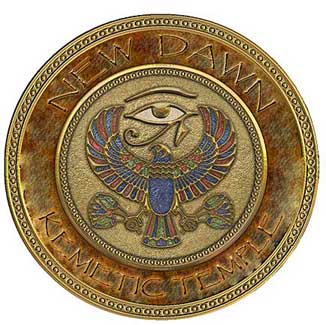|
|
|


~Jefferson Monet~
During the classical age, there was no other aspect of Egyptian
religion that elicited more derision from writers than the aspect of Egyptian
animal worship. Among the various cults established by the ancient Egyptians,
it seems to many even today to be one of the most strange and mysterious. There
is evidence of animal cults that dates back to at least the fourth millennium
BC in Egypt, including predynastic ritual burials of animals such as gazelles,
dogs, cattle, monkey and rams at sights such as Badari, Naqada, Maadi and Heliopolis.
Erik Hornung notes that "the care with which these animals were buried
and provided with grave goods is evidence for a cult of sacred animals".
There is really no evidence of very early animal cults during Egypt's neolithic
period, but by the last centuries of prehistory, there can be scarcely any doubt
that the Egyptians worshipped divine powers in animal form. While the earliest
evidence of the cult surrounding the Apis bull dates to the reign of King Aha
of the 1st Dynasty, various animal cults received considerable emphasis beginning
with the twenty-sixth dynasty, perhaps as a part of a resurgence of Egyptian
nationalism.
In reality, animals were rarely if ever worshipped as gods in ancient Egypt, but were instead thought of as manifestations of the gods. Like cult statues, they were actually one vehicle through which the gods could make their will manifest, and through which the faithful could demonstrate their devotion to the gods. Therefore, individual animals were cot considered gods, but the god could take up his abode in them and they become become an image of the god and a vessel for him.
In fact, the keeping of sacred animals seems a very logical extension of early many cult statues. Horus, for example, was frequently depicted in statuary and on temple walls in his manifestation as a fully formed falcon, so it is understandable that the ancient Egyptians might also venerate the living, breathing animal.
We may categorize three different types of sacred animals that were honored by the ancient Egyptians. The temple animals, one type, functioned very similarly to the cult statues in temples. These animals lived in or near a temple and were distinguished by special markings. The Apis bull of Memphis, for example, had to be a black bull with a white triangle on its forehead, a crescent moon on its chest and another on its flanks, as well as having black and white in its tail. It was though to be the ka manifestation of Ptah, and like cult statues, these animals could visit other deities in their temples as well as give oracles. At certain times of the day, the bull would be released into a courtyard where worshippers would gather to see him and receive oracles. Oracles were questions that had either a yes or no answer, and this answer was received when the bull entered into one of two stables. Upon the death of the Apis bull, it was elaborately embalmed and there was a time of general mourning. It was then buried in an enormous stone sarcophagus in the Serapeum at Saqqara, after which a search would be made for its replacement.
There were a number of other bulls that were worshipped in this manner, including the Mnevis bull at Heliopolis, which was the manifestation of Atum-Re and the Buchis bull at Hermonthis, which represented Montu and was particularly important during the reign of Nectanebo II. Other animals included the ram of Mendes, which was considered the manifestation of Osiris-Re, and the ram of Elephantine which was associated with Khnum.
A second class of sacred animals were those kept in large numbers near a temple. In animal cults, we encounter the ability of Egyptian gods to extend their existence almost endlessly so that they could be manifest not just in one ibis or crocodile, but in all ibises or all crocodiles. At Saqqara, for example, there was an extensive complex of buildings dedicated to the priestly care of large flocks of ibises, considered to be the manifestation of Thoth, and of falcons, who represented Horus. These flocks provided the enormous number of animal burials found in Egypt, which included literally millions of mummified animals in necropolises throughout the country. Besides the ibis necropolis at Saqqara, there are necropolises for cats at Bubastis, rams at Elephantine, crocodiles, snakes, falcons and ibises at Kom Ombo and ibises and falcons at Abydos.
The burial of sacred animals were frequently paid for by pilgrims during visits to the temples at festivals or when seeking divine blessings, and this must have created a considerable priestly industry for animal mummification. The mummified animal corpse served as a votive offering for the god, and the devotee obviously expected to earn the goodwill of the deity by providing for the burial of one of its sacred animals. For example, one inscription preserved on a jar containing an ibis mummy is a prayer asking Thoth to be benevolent toward the woman who had embalmed his sacred animal. One wonders whether these animals were kept for this specific reason, and to profit the temple, for while only one temple animal was kept at any one time, which received a cult, this second class of sacred animal was kept in large numbers and really received no cult. Obviously the burial of the temple animals was also much more elaborate.
A third type of sacred animal were those kept in private
homes as representative of the gods. They included snakes, cats, dogs and other
animals, which were kept in cages and buried upon their death. This practice
is analogous to the construction of household shrines to allow for domestic
worship. However, one must wonder how Egyptologists distinguish between animals
kept in private homes for spiritual reasons, and those that were simply kept
as pets.